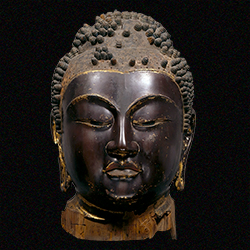2017年11月22日(水)、入場者が50万人に達しました。
2017年11月14日(火)、入場者が40万人に達しました。
2017年11月2日(木)、入場者が30万人に達しました。
2017年10月24日(火)、入場者が20万人に達しました。
1089ブログ「運慶」 展覧会の見どころなどを紹介しています。
東京国立博物館 資料館 興福寺中金堂再建記念特別展「運慶」関連図書コーナー設置
投票・アンケート 「京都・浄瑠璃寺伝来 重文・十二神将立像 あなたが守り神にしたいのはどのお像?」 結果発表 (投票期間:2017年10月11日(水)~11月26日(日))
展覧会のみどころ
第1章 運慶を生んだ系譜ー康慶から運慶へ
第2章 運慶の彫刻ーその独創性
第3章 運慶風の展開ー運慶の息子と周辺の仏師
第1章 運慶を生んだ系譜ー康慶から運慶へ
運慶の生年は不明ですが、息子・湛慶(たんけい)が承安3年(1173)生まれであること、処女作と見られる円成寺の大日如来坐像(だいにちにょらいざぞう、国宝)を安元元年(1175)に着手していることから、おおよそ1150年頃と考えられます。平等院鳳凰堂の阿弥陀如来坐像(あみだにょらいざぞう、国宝、天喜元年(1053))の作者である大仏師・定朝(じょうちょう)から仏師集団は三つの系統に分かれましたが、運慶の父・康慶(こうけい)は興福寺周辺を拠点にした奈良仏師に属していました。院派(いんぱ)、円派(えんぱ)の保守的な作風に対して、奈良仏師は新たな造形を開発しようとする気概があったようです。
ここでは、運慶の父あるいはその師匠の造った像と、若き運慶の作品を展示し、運慶独自の造形がどのように生まれたのか、その源流をご覧いただきます。

写真:飛鳥園
国宝 大日如来坐像(だいにちにょらいざぞう)
運慶作
平安時代・安元2年(1176)
奈良・円成寺蔵
台座の裏に墨書があり、運慶が「安元元年十一月廿四日」に造仏の注文を受けて造り始め、「同二年十月十九日」に完成した像を引き渡したことが知られる。銘文は運慶自身が書いたもので、末尾に「大仏師康慶実弟子運慶」と記し、署名している。現存するもっとも早い運慶の作品で、時間をかけて入念に造ったのだろう。溌剌とした表情と体格、きれいに梳いた髪のふくらみなど写実的で、運慶の類まれな才能を感じることができる。
重要文化財 仏頭(ぶっとう)
運慶作
鎌倉時代・文治2年(1186)
奈良・興福寺蔵
享保2年(1717)に焼失した興福寺西金堂の本尊、釈迦如来坐像(しゃかにょらいざぞう)の頭部として伝来した。鎌倉時代の興福寺の記録によると「文治二年正月二十八日」に運慶が大仏師として完成した像の堂内安置に関わったことが知られる。従って運慶が造像したと見られるが、同じ年に造った願成就院(がんじょうじゅいん)の阿弥陀如来坐像(あみだにょらいざぞう)との作風に開きがあり、運慶がどこまで関与したかはっきりしない。
国宝 運慶願経(法華経巻第八) (うんけいがんぎょう ほけきょうまきだいはち)(部分)
平安時代・寿永2年(1183)
治承4年(1180)、平重衡(たいらのしげひら)の軍勢が放った火によって東大寺、興福寺の主要伽藍(がらん)が焼失した。運慶は幼少のころから両寺院の仏像、伽藍に親しんでいたはずで、深く胸に刻まれる事件だっただろう。焼け残った東大寺大仏殿の木を軸にして法華経八巻の書写を発願した。紙は工人に沐浴精進させて作らせ、水は比叡山横川(よかわ)、園城寺(おんじょうじ)、清水寺から霊水を取り寄せて墨をすっている。巻第八の奥書に快慶をはじめ結縁した同僚の仏師の名前がある。
展覧会のみどころトップへ
第2章 運慶の彫刻ーその独創性
文治2年(1186)に運慶が造った静岡・願成就院(がんじょうじゅいん)の阿弥陀如来坐像(あみだにょらいざぞう)、不動明王(ふどうみょうおう)および二童子立像(にどうじりゅうぞう)、毘沙門天立像(びしゃもんてんりゅうぞう、いずれも国宝)の5体には全く新しい独自の造形が見られます。建久8年(1197)頃の高野山金剛峯寺(こんごうぶじ)の八大童子立像(はちだいどうじりゅうぞう、国宝)は入念な玉眼(ぎょくがん)の表現、立体的に表した頭髪と墨描した後れ毛などが写実性に富み、感情までも表現されています。晩年の無著菩薩立像(むじゃくぼさつりゅうぞう、国宝)・世親菩薩立像(せしんぼさつりゅうぞう、国宝)は、圧倒的な存在感と精神的な深みが感じられます。鎌倉時代の人々が仏像に求めたのは、仏が本当に存在するという実感を得たい、ということだったでしょう。運慶はその要求を受け止めて、余すところなく応えたのです。
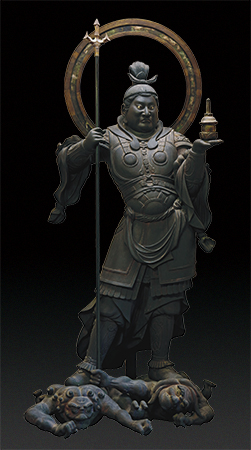
写真:六田知弘
国宝 毘沙門天立像(びしゃもんてんりゅうぞう)
運慶作
鎌倉時代・文治2年(1186)
静岡・願成就院蔵
像内に納められていた五輪塔形の銘札の墨書から、文治2年(1186)に北条時政(ほうじょうときまさ)の発願により運慶が造ったものとわかる。北条氏の本拠地である伊豆韮山(にらやま)に創建された願成就院(がんじょうじゅいん)に安置されている5体のうちの1体。引き締まった体で左に腰を捻って立ち、力がみなぎって今にも動き出しそうである。武将のような顔つきも毘沙門天像にはめずらしい。奈良と伊豆のどちらで制作したかは不明だが、願成就院の像には運慶の独創性がいかんなく発揮されており、この時までに独自の作風を樹立したことが知られる。鎌倉幕府の御家人にこの作風が喜んで迎えられ、東国が慶派仏師の活躍の場になった。
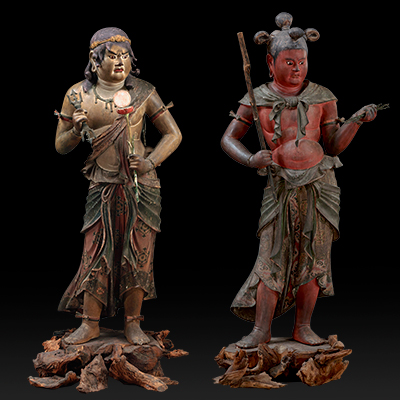
左から恵光童子、制多伽童子
写真:高野山霊宝館
国宝 八大童子立像のうち恵光童子・制多伽童子(はちだいじどうじりゅうぞう のうち えこうどうじ・せいたかどうじ)
運慶作
鎌倉時代・建久8年(1197)頃
和歌山・金剛峯寺蔵
平安時代後期、12世紀作の不動明王像に随う八大童子として造られたもので、6体が運慶作、2体は後補である。八条女院という高貴な女性の発願だからか、経典で性悪とされる制多伽童子が理知的な顔に造られるのをはじめ、いずれも上品な姿である。玉眼は視線の強さ、あるいは聡明さなどを巧みに表し、生きているように見える。造像時の華麗な彩色もよく残っている。運慶作品の中でも完成度の高さで屈指の作である。
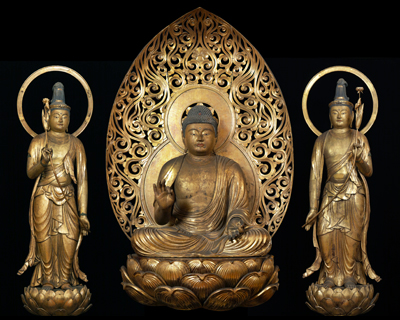
阿弥陀如来坐像および両脇侍立像
写真:六田知弘
重要文化財 阿弥陀如来坐像および両脇侍立像(あみだにょらいざぞう および りょうきょうじりゅうぞう)
重要文化財 不動明王立像(ふどうみょうおうりゅうぞう)
重要文化財 毘沙門天立像(びしゃもんてんりゅうぞう)
運慶作
鎌倉時代・文治5年(1189)
神奈川・浄楽寺蔵
[展示期間:阿弥陀如来および両脇侍立像は2017年10月21日(土)~]
不動明王立像と毘沙門天立像に納入されていた銘札により、鎌倉幕府の有力な御家人である和田義盛(わだよしもり)とその夫人の発願により、運慶が造ったことがわかる。阿弥陀如来坐像および両脇侍立像は肥満した体と生気のある表情で存在感と現実味に富む。不動明王像と毘沙門天像は、願成就院像の斬新に比べて古典的である。両者の違いの理由は不明だが、発願者の好みを反映したとも考えられる。

左から世親菩薩立像、無著菩薩立像
写真:六田知弘
国宝 無著菩薩立像・世親菩薩立像(むじゃくぼさつりゅうぞう・せしんぼさつりゅうぞう)
運慶作
鎌倉時代・建暦2年(1212)頃
奈良・興福寺蔵
北円堂は、奈良時代に藤原不比等(ふじわらのふひと)の供養のために建立されたが、治承4年(1180)の兵火で焼失、復興は遅れ承元2年(1208)にようやく造仏が始まった。弥勒如来坐像(みろくにょらいざぞう)と両脇侍像、二羅漢(らかん)、四天王像の造像は運慶統率のもと6人の子、4人の弟子たちが分担した。無著、世親は5世紀、北インドに実在した学僧で、法相(ほっそう)教学を体系化したことで知られる。無著が兄、世親は弟であり、2体の像は老年と壮年に作り分けられている。2メートルに迫る巨体に厚手の衣を着け、大ぶりな衣文を作って重厚な存在感を表す。一方容貌は無著の静、世親の動と対照しつつ精神的な深みを加えている。世界的な傑作と言って良い。

写真:六田知弘
寺外初公開!
重要文化財 聖観音菩薩立像(しょうかんのんぼさつりゅうぞう)
運慶・湛慶作
鎌倉時代・正治3年(1201)頃
愛知・瀧山寺蔵
建久10年(1199)に没した源頼朝の供養のため、頼朝の従兄弟にあたる僧・寛伝(かんでん)が造った像。『瀧山寺縁起(たきさんじえんぎ)』には、聖観音像の像内に頼朝の髪と歯が納められたと記され、X線写真により、頭部内に納入品が確認されている。脇侍の梵天(ぼんてん)・帝釈天(たいしゃくてん)を合わせ三尊とも作者は運慶・湛慶(たんけい)とする。肉付きの良い体体と写実的な着衣の表現など運慶の特色が顕著で、『瀧山寺縁起』の記述は信用できる。表面の彩色は後補。聖観音菩薩立像が寺から外に出るのは初めてである。
展覧会のみどころトップへ
第3章 運慶風の展開ー運慶の息子と周辺の仏師
運慶には6人の息子がおり、いずれも仏師になっています。そのうち、単独で造った作品が残るのは湛慶(たんけい)・康弁(こうべん)・康勝(こうしょう)です。ここでは湛慶と康弁の像を展示します。運慶の後継者として13世紀半ばまで慶派仏師を率いた湛慶は多くの作品を残しました。快慶とともに造像したこともあるためか、運慶の重厚な作風より快慶の洗練に近づいています。しかし、京都・高山寺(こうさんじ)の牡牝一対の鹿や子犬(いずれも重要文化財)、高知・雪蹊寺(せっけいじ)の善膩師童子立像(ぜんにしどうじりゅうぞう、重要文化財)などの写実性と繊細な情感表現は、運慶風を継承したものです。康弁作の龍燈鬼立像(りゅうとうきりゅうぞう、国宝)は力士のようなモデルの存在を思わせる筋肉の表現において、より直接的に運慶とつながっています。このほか、運慶にきわめて近い作風の像を展示します。

亥神
写真:京都国立博物館(岡田愛)
42年ぶりに12体勢ぞろい!
重要文化財 十二神将立像(じゅうにしんしょうりゅうぞう)
京都・浄瑠璃寺伝来
鎌倉時代・13世紀
東京・静嘉堂文庫美術館蔵(子神・丑神・寅神・卯神・午神・酉神・亥神)
東京国立博物館蔵(辰神・巳神・未神・申神・戌神)
九体阿弥陀と浄土庭園で知られる浄瑠璃寺(じょうるりじ)に伝来した像。明治時代初頭に寺を離れ、民間に流出したが、現在は静嘉堂文庫美術館と東京国立博物館の2カ所の所蔵となっている。この12体が一堂に会するのは、昭和50年(1975)に東京国立博物館が開催した「鎌倉時代の彫刻」展以来である。12体の表情、姿勢は変化に富み、像表面に施された装飾も造られた当時のものがよく残っている。明治35年(1902)11月22日付けの毎日新聞の記事に「大仏師運慶」という銘があったと紹介されていることが最近話題になったが、その銘文はまだ確認されていない。
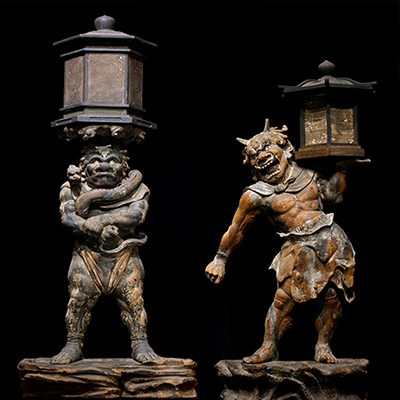
左から龍燈鬼立像、天燈鬼立像
写真:六田知弘
国宝 天燈鬼立像・龍燈鬼立像(てんとうきりゅうぞう・りゅうとうきりゅうぞう)
康弁作(龍燈鬼立像)
鎌倉時代・建保3年(1215)
奈良・興福寺蔵
龍燈鬼の像内に納入されていた文書に建保3年、康弁によって造られたことが記される。龍燈鬼の頭上に乗せた燈籠を上目遣いで見る顔は、滑稽である。げじげじ眉毛を切り抜いた銅板で作り、牙は水晶製。両腕、臀部、大腿部の筋肉表現は鍛え上げた人物を傍にして彫ったと思えるほど写実的である。東大寺南大門の金剛力士像に通ずるもので、康弁が運慶から学び、継承したことがわかる。
展覧会のみどころトップへ



